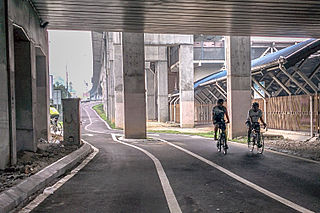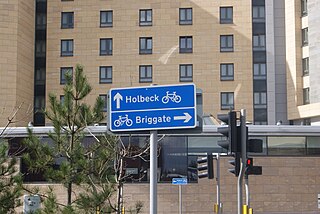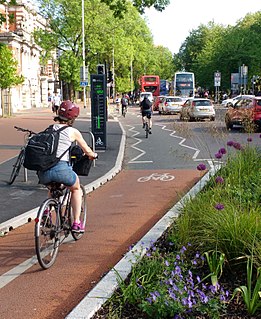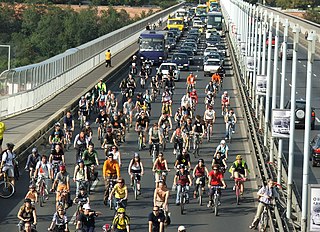 W
WCycling in Auckland is a mode of transport which has historically had high levels of modal share in Auckland, New Zealand, like in most cities in New Zealand. However, the dominance of the car in the city, the negative attitudes of car drivers and general changes in transport patterns had made it a very marginal transport mode in the early 21st century, with remaining cyclists often riding for leisure and sports purposes.
 W
WCycling in Berlin is a significant form of transport in the German capital where around 500,000 daily bike riders accounted for 13% of total traffic in 2010. The city has a highly developed bicycling infrastructure and it is estimated that Berlin has 710 bicycles per 1000 residents. Among cities with more than one million inhabitants Berlin is a metropolis with one of the highest rates of bicycle commuting in the world.
 W
WCycling in Cardiff, capital of Wales, is facilitated by its easy gradients and large parks. In the mid-2000s between 2.7% and 4.3% of people commuted to work by cycling in the city. In 2017 12.4% of workers cycled to work at least 5 days a week. However, cyclists in the city are deterred from cycling by poor facilities and aggressive traffic, according to research by Cardiff University.
 W
WCycling in Copenhagen is – as with most cycling in Denmark – an important means of transportation and a dominating feature of the cityscape, often noticed by visitors. The city offers a variety of favourable cycling conditions — dense urban proximities, short distances and flat terrain — along with an extensive and well-designed system of cycle tracks. This has earned it a reputation as one of the most—possibly the most—bicycle-friendly city in the world. Every day 1.2 million kilometres are cycled in Copenhagen, with 62% of all citizens commuting to work, school or university by bicycle; in fact, almost as many people commute by bicycle in greater Copenhagen as do those who cycle to work in the entire United States. Cycling is generally perceived as a healthier, more environmentally friendly, cheaper, and often quicker way to get around town than by public transport or car.
 W
WCycling in Kuala Lumpur refers to the bicycle uses in Kuala Lumpur, Malaysia for touring, recreational, work and transportation purpose. It was first appeared on 1938 when there is a first road cycling race that has been introduced in Kuala Lumpur. The introduction of the bicycle in Kuala Lumpur was later become one of the preferred transportation methods for students and mid-class citizens. As Kuala Lumpur begin its rapid urbanization progress since 1960s, the usage of bicycle start to decline as people shifting their transportation method to driving. In recent years however, the roads of the city have seen an increased presence of cyclists, whereas the importance of doing exercise has become more recognized. To match this positive change, and to reduce air pollution, the city urgently needs the introduction of more pavements and bicycle lanes, ideally by leveraging on the vast area that is currently taken up by motorways. Given that Kuala Lumpur lacks many bicycle-friendly routes suitable for cyclists in the city, however, proposals of a bicycle infrastructure of urban bicycling program were drafted, mainly under the Kuala Lumpur Structure Plan 2020 and cycling activism by Cycling Kuala Lumpur in order to encourage more citizens of Kuala Lumpur to cycle in the urban area.
 W
WCycling is a popular means of both transport and leisure in Leeds. The city hosted a number of cycling events, the most notable being the Grand Depart for the 2014 Tour de France.
 W
WCycling in London is a popular mode of transport and leisure activity within the capital city of the United Kingdom. Following a national decline in the 1960s of levels of utility cycling, cycling as a mode of everyday transport within London began a slow regrowth in the 1970s. This continued until the beginning of the 21st century, when levels began to increase significantly - during the period from 2000 to 2012, the number of daily journeys made by bicycle in Greater London doubled to 580,000. The growth in cycling can partly be attributed to the launch in 2010 by Transport for London (TfL) of the Santander Cycle Hire system throughout the city's centre. By 2013, the cycle hire scheme was attracting a monthly ridership of approximately 500,000, peaking at a million rides in July of that year. Health impact analyses have shown that London would benefit more from increased cycling and cycling infrastructure than other European cities.
 W
WCycling for transport and leisure enjoys popularity in Greater Manchester and the city also plays a major role in British cycle racing. The University of Manchester is home to the Manchester Cycling Lab.
 W
WCycling in Melbourne, the capital city of Victoria, Australia, is enhanced by the city's relatively flat topography and generally mild climate. The city has an active cycling culture for commuting, recreation, fitness and sport, and the metropolitan area has an extensive network of off-road bicycle paths, as well as designated bicycle lanes on many streets.
 W
WCycling in Munich accounts for 18% of all traffic in the German city of Munich. This makes Munich the leader in bicycle modal share amongst the large German cities; as a result, Munich named itself Germany's Radlhauptstadt in the summer of 2010. Around 80% of the population of Munich own a bicycle.
 W
WCycling in Penang Island refers to the use of bicycles in the city of George Town and elsewhere on Penang Island, Malaysia, either for recreational, touring or transportation purposes. While bicycles have long been in use in Penang, with rickshaws becoming a unique application of the pedal-driven vehicle in the state, the usage of bicycles has noticeably declined since the late 20th century due to the proliferation of cars as the main transportation mode.
 W
WCycling in Prague is a popular leisure activity and not so common mode of transport within the capital city of the Czech Republic. However, levels of utility cyclists are rising every year. In 2018, 2% of people commute by bike in Prague. As of 2017, there were 178 km (111 mi) of protected cycle paths and routes in the city. Also, there were 48 km (30 mi) of bike lanes and 24 km (15 mi) of specially marked bus lanes that are free to be used by cyclists.
 W
WCycling in Toronto, Ontario, Canada, like many North American cities, has slowly been improving its cycling infrastructure. The number of cyclists has been increasing progressively, particularly in the core. As cycling conditions improve, a cycling culture has grown and alternatives such as automobiles are seen as less attractive. The politics of providing resources for cyclists, particularly dedicated bike lanes, has been contentious in the 2010s.